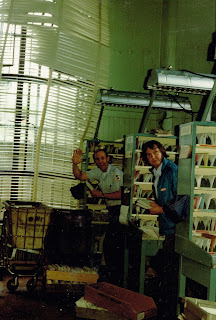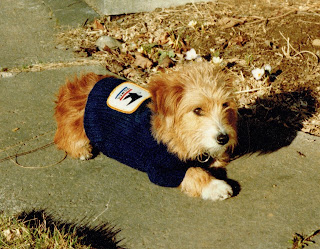So they’re going to redesign the Postal Vehicles again. Probably a good idea. Mail carriers deliver mostly packages now and their vehicles are set up to deliver antique letter mail from twenty years ago. But they used to change the vehicles every now and then just to rattle the crew.
I personally preferred the ones we started with in the ’70s. They were little right-hand-drive Jeeps and you could reach everything you needed from the front seat without dislodging a butt cheek. Each one had its own idiosyncrasies. If you were a lowly sub, you’d get to choose something particularly quirky from the bottom tier of the fleet. It took a certain amount of mental agility to switch from the one with the window that wouldn’t go down to the one where you had to stand on the gas and the brake at the same time to modulate your speed. I hadn’t been working there too long before the day I tried to save time by sliding open my door as I was coasting up to a stop, and it slid clear off its rails and cartwheeled down the street behind me. Fortunately no bystanders got decapitated but I do remember looking in my rear-view mirror and thinking: even without a decapitation event, this isn’t ideal. I could probably get in trouble for this. But I backed up, hauled the door off the pavement, and stuck it back on the rails good as new, making a mental note that Jeep 998 is the one where you have to be careful of the door, and if I had a choice, I’d try to get the one where the engine didn’t turn off even when you took the key all the way out. Because that one had a stellar emergency brake.
 |
| A tidy bunch |
Big change after the first couple years. The Jeeps were repainted WHITE red and blue from the former BLUE red and white. The extra paint gave the rivets a little more integrity. We got used to the white. Everyone liked to use Route 532’s Jeep because the carrier, a neat dresser with aviator shades and a lounge-lizard beard, had it tricked out with wall-to-wall carpeting. For me, it didn’t make up for the cigar stench or the fug from the pine-tree deodorizer.
The Jeeps were troublesome but entirely too useful and soon enough we had them all swapped out for Ford Pintos. The big hump running down the middle for the power train proved to be a pain in the ass to arrange mail trays around, but worse, Pintos were already famous for blowing up whenever someone tapped them on the rear bumper, which is probably why the Postal Service got them cheap. And whenever we drove them up to a stop sign, we could hear an ocean of fuel sloshing back and forth underneath us like an ominous tide. It was like straddling a low-tech rocket. For the first time, we had three-point seat belts, too, so we wouldn’t be able to bail out immediately when we were set on fire. Nobody missed them when they were towed away.
A few forgettable station wagons (K-Car? Aerostar?) were trundled out and abandoned and then they
came up with the first vehicle specifically designed for us, and not whacked together out of an existing fleet with extra trays bolted on. The LLV was supposed to last for twenty years, and maybe it would under the care of someone who had purchased it for personal use, but the best of us sought only to keep the daily damage to a minimum. The LLV required actual training to operate. It was an opaque box. There would be no looking over your shoulder to back up. Instead, it was decked out with dozens of mirrors on all corners, some of which were aimed at other mirrors so that you could make out what you were about to back into, as long as you knew which mirror to check and as long as it wasn’t raining; and some of the mirrors were purely there for extra jazz. Most of us were never sure if we were looking at traffic coming up on our left, traffic behind us, or a video of little toy cars. We each had half-day training on the LLVs and were pronounced good to go as soon as we could drive five minutes without crushing an orange cone.
Within a few months all the predictable problems were solved by a new edict from Management that we were no longer allowed to put our vehicles in reverse. This meant we couldn’t get in or out of the garage. The edict was altered slightly so that you could put your vehicle in reverse if no one was watching, but if you hit something, it was totally your fault because they warned you.
These are the vehicles that are being phased out now. The new ones will allow you to stand up in the back and have lots of room for packages. The mirror situation probably won’t have improved. If you have to track the trajectory of your sliding door as it goes sailing down the street now, you’re probably out of luck.



Our local carriers are "contractors" and drive their own personal vehicles. I remember most of the cute little trucks and always wanted to convert one for camping. I figured it wouldn't go far so it needed to be very well equipped for a long stay.
Yeah, they were adorable. And you are right. They wouldn't go far. We had one route that was so far away from the station you were advised to bring a blanket and provisions.
Saya sangat bersyukur atas rahmat yg diberikan kepada saya dibulan ini karna alhamdulillah melalui MBAH RAWA GUMPALA saya sekaran sudah bisa sukses atas nomor yg diberikan kepada saya dan saya yg dulunya cuma seorang TKW dari singapur yg gajinya tidak pernah mencukupi kebutuhan keluarga saya dikampun dan alhamdulillah berkat bantuan MBAH RAWA GUMPALA kini saya sudah bisa pulang kampun,saya bersama keluarga dikampun sudah punya usaha sendiri dan saya tidak pernah menyanka kalau saya bisah seperti ini,jika anda ingin seperti saya silahkan hubungi MBAH RAWA GUMPALA di nomor 085-316-106-111…karna alhamdulillah saya menan nomor togel dari MBAH dan kalau uang indonesia 750 juta,,ini bukan rekayasa dari saya dari IBU RISKA.untuk lebih lenkapnya silahkan buka SITUS MBAH RAWA GUMPALA
Saya sangat bersyukur atas rahmat yg diberikan kepada saya dibulan ini karna alhamdulillah melalui MBAH RAWA GUMPALA saya sekaran sudah bisa sukses atas nomor yg diberikan kepada saya dan saya yg dulunya cuma seorang TKW dari singapur yg gajinya tidak pernah mencukupi kebutuhan keluarga saya dikampun dan alhamdulillah berkat bantuan MBAH RAWA GUMALA kini saya sudah bisa pulang kampun,saya bersama keluarga dikampun sudah punya usaha sendiri dan saya tidak pernah menyanka kalau saya bisah seperti ini,jika anda ingin seperti saya silahkan hubungi MBAH RAWA GUMPALA di nomor 085-316-106-111…karna alhamdulillah saya menan nomor togel dari MBAH dan kalau uang indonesia 750 juta,,ini bukan rekayasa dari saya dari IBU RISKA.untuk lebih lenkapnya silahkan buka SITUS MBAH RAWA GUMPALA
And we wonder why we have the phrase "going postal."
Some of my coworkers were offended by that phrase but I always took it as a point of pride.
Then when service is cut to five or maybe four days, will the Service need fewer or more vehicles?
Same number. Less gas. I guess.
This has nothing to do with their trucks, but with their walking routes. About 15 years ago, when we had just moved into our house, I started planting a border all around the front — mostly bulbs, but some native plants and some lilac saplings. The mail carrier kept tramping through there instead of using our front walk, destroying plants in the process. I asked him to use the front walk, and he said that I'd have to take it up with the local post office branch. They were supposed to use the shortest possible way to get to the next mailbox, even if it's through someone's attempt at growing plants. So I did. I was told that he was correct, and that if I wanted him to use the front walk, I had to draw a diagram of my front yard with the path I wanted him to take designated, and file it with them. *Headdesks* There's no one like the Federal government for taking something that should be simple ("Please use my front walk instead of my flower beds." "Okay.") and make it more complicated than it needs to be.
My lilac saplings have since grown into a hedge, and the plants have taken over. He would need a machete to get to the neighbor's mailbox through there now.
Yup–we were supposed to take the shortest route, unless we were specifically requested not to. Our routes were in wealthy areas and the lawns were such that you KNEW you weren't supposed to traipse across. Postal work is like any other work. It comes down to the individual. It can be done well or badly. Doing it well costs the company more. (And you know it's not the federal government running it, right? No tax money involved either.)
Murr, you give me such insight into the post office! thank you.
Because that's what you needed. The post office ran a lot smoother when it ran on alcohol.
Our posties have (very) tired motor bikes to deliver letters. And a neighbour brings his home for lunch. In the city they get a granny trolly instead.
Parcels are mostly contractors. The occasional postal van I suspect is delivering lunch to the workers rather than anything to the public.
I always wanted a Segway. Or a llama.
I'm probably the last person in the US of A who still writes and mails letters. Rather than go an additional fifty feet to the end of the street, our mail carrier likes to do a U-ey right in front of our house, and is forever knocking a stake over. (A stake my husband put there with the express purpose of preventing him from using our yard as a turn-around spot. Didn't work.)
I did a U-turn in someone's driveway on a dead-end once. Hit the house. I was still on probation. They said they had to tie the poor woman who lived there to the mail box for weeks so she could get used to the sound of the mail truck and not freak out.
Replace that stake with a big ol' rock.
What? You don't think we could high-center ourselves on a big ol' rock?
Until now, those of us on the receiving end of mail delivery had no idea the troubles you people have getting our precious packages to us.
Here's a public thank you, from me at least, and anyone else who wants to join in.
Did I mention five dog bites? 🙂
Here in the burbs we have super mailboxes that are stuffed daily with tons of admail and the occasional paper bill. Mail comes to and goes from the boxes by contractors as well as post office folks, unionized. Parcels have to be picked up at postal outlets. UPS is becoming more and more popular with internet shoppers because they come to the door.
Loved door to door service as a kid ; milk, bread and mail 🙂
It's all grandfathered in. If you're in a house with a mail slot, you get to keep it. It's just the new developments and houses that have to have the streetside boxes. The other new thing is there's nothing in the mail that you ever want. Used to be there was the occasional interesting item.
Not only is there next to nothing interesting in the traditional mail, now all I get in my e-mail is junk. If I route it all to the spam file, I'd get nothing. It's all texts now. Times change fast these days.
Oh-I forgot. Where I live, anything ordered from, say, Amazon that gets Sunday delivery is delivered by someone in a USPS vehicle. I am told it's because of a contract between UPS and USPS. Strange times.
I know there's a relationship between USPS and FedEx. Hmm. I can't keep up. I liked it all better Back In The Day.
And have you ever noticed that there are so many ways to get hold of people now that you have to know which one your friends respond to? Like, someone always responds to text messages but is really pokey with email. Personally, I'm pretty good with email but suck at phone messages, voice mail, IMs, and calling on the land line.